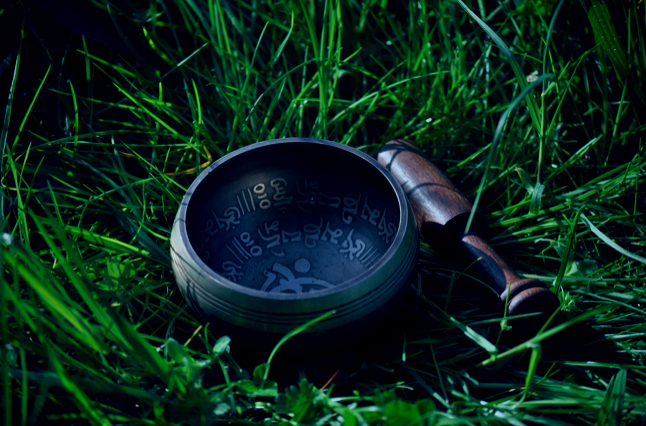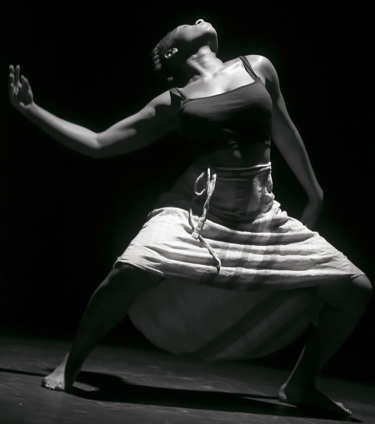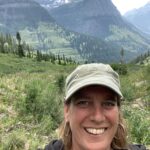As a college student, in my twenties, I studied Modern Dance and Buddhism. I learned to meditate in a classroom on the third floor of the oldest building on campus in old rickety wooden desks. In that stale classroom, I learned to follow my breath and cultivate loving kindness. Even though both of these meditations are as old as the forests the Buddha taught them in, they both felt like a radical divergence from current modern life.
A decade later, I was still exploring dance (as a healing art), and meditation (as mind training), whilst honing my focus towards their intersection. I found Authentic Movement, or AM, and practiced this discipline. This further developed my inner witness while simultaneously learning to be witnessed by another. AM cultivates moving from bodily impulses. It requires one to listen to the body and quiet the mind, much like meditation.

I did an exploration once with a group of movers to explore the dynamics between stillness and movement. I invited everyone to begin by sitting still, following the breath and sensations in their body. Then, I rang a bell, which invited them to begin moving. I rang the bell again, and everyone stopped. We sat in silence – following our breath and sensation.
I rang the bell several times while the class moved silently in and out of stillness.
The Body
When I taught meditation I often listened to people say how hard it is to sit still. Many gave up after awhile. Whether the restlessness is in the body or mind, it can and does take time to train oneself to sit and be with whatever is there – day after day, moment after moment.
Traditionally, there is walking meditation as well as ancient moving meditation practices like Tai Chi or Qi Gong, which help integrate the mind and body through slow intentional movements. The practice of cultivating awareness needs somewhere to land. If it only stays in the mind, never landing fully in the body, then after many years of meditating one might find themselves stuck or no longer experiencing the benefits.
I saw this happening around me with long-time meditators, and with myself, as I continued to study and explore meditation over the years.
I started wondering, “Where is the body in all of this mind training?”
The meditation instructions included the body, but the lack of embodiment in the people instructing the meditation, including myself, left a gap in translation.

For me, learning the emotional equivalents to my intellectual understandings was a jumping off point, a guide, to diving deeper into what was really happening when I sat down to meditate.
This surprisingly led me to stop meditating formally, for a time.
Instead, I took my meditation, and my aspiration to cultivate mindfulness, into as much of my daily life as I could.
This meant paying more attention to my body and its sensations throughout the day.
What was my body doing while I washed the dishes? Was I hunched over, muscles contracted, lost in thought? Yes, often.
What about while driving? What are my hands doing? My shoulders? My legs?
I noticed more and more what was happening in my body while in motion, while not in motion, and in the spaces in-between. I would stop mid-scrub, square my feet under my hip bones, put a bend in my knees, drop my shoulders, tuck my chin, my pelvis, and allow a deeper breath to enter in.
A softening comes every time.
Still, there was more going on that I couldn’t put my finger on, so I kept diving.

The Nervous System
We hear all the time to “breathe deeply”, or, “take a breath”. In meditation, we’re invited to simply notice the breath. Follow it as it enters and exits the body.
The breath is important.
Essential, in fact.
Breathing is part of our autonomic nervous system, meaning we don’t have to think about breathing, or remember to breathe. Our bodies breathe automatically, same as our heart beat and circulation, swallowing. It all happens without us ever having to think about it.
However, the state of our nervous system can greatly affect the quality of our breathing and the rate of our pulse. This, in turn, influences how we feel in our body.
If our sympathetic nervous system is activated, which is what mobilizes our bodies to get away from danger and into safety, our breathing becomes shallow, our heart rate increases, our vision narrows, our need for food vanishes, and our blood circulates to the extremities – all in preparation for us to fight or flee (or both) when danger is present.
It’s our evolutionary intelligent design.
If the bookcase next to us falls over, we don’t think about whether we should jump out of the way, we just move. Our bodies are designed to keep us safe. Our nervous systems are designed to alert us to danger, mobilize us to get away, seek safety.
Once safe, our nervous system shakes off the adrenaline and cortisol that gets dumped into our bodies to aid in our survival, and resets back to baseline. Our parasympathetic system comes online, our breath gets deeper, heart rate slows down, and we can enjoy a good meal and deep sleep.
However, if that process is interrupted, which it often is, then our nervous systems stays locked in activation, and our bodies (and minds) think and act as though still in danger. This is the all too common state of the modern human.
Our cognitive higher thinking brains get in the way of our intelligently designed bodies to reset back to the resilient state of calm and readiness we are designed for.
Because the felt sense of our experience (ie: emotions and sensations) take longer to catch up, to integrate, than our cognitive minds, it is imperative that we create more creative, non-linear, s l o w time and space for our minds and bodies to just be.
Whether it’s in movement or stillness. Or moving into stillness.


Ann Campbell is in the final stages of certification as a Somatic Experiencing Practitioner helping people rewire their nervous systems one spontaneous breath at a time, as well as a Nature Connection Mentor in the field of Relational Education. She facilitates deeper understanding and awareness of the body-mind connection thru bottom-up processing and listening to the birds. She currently lives in Missoula.
